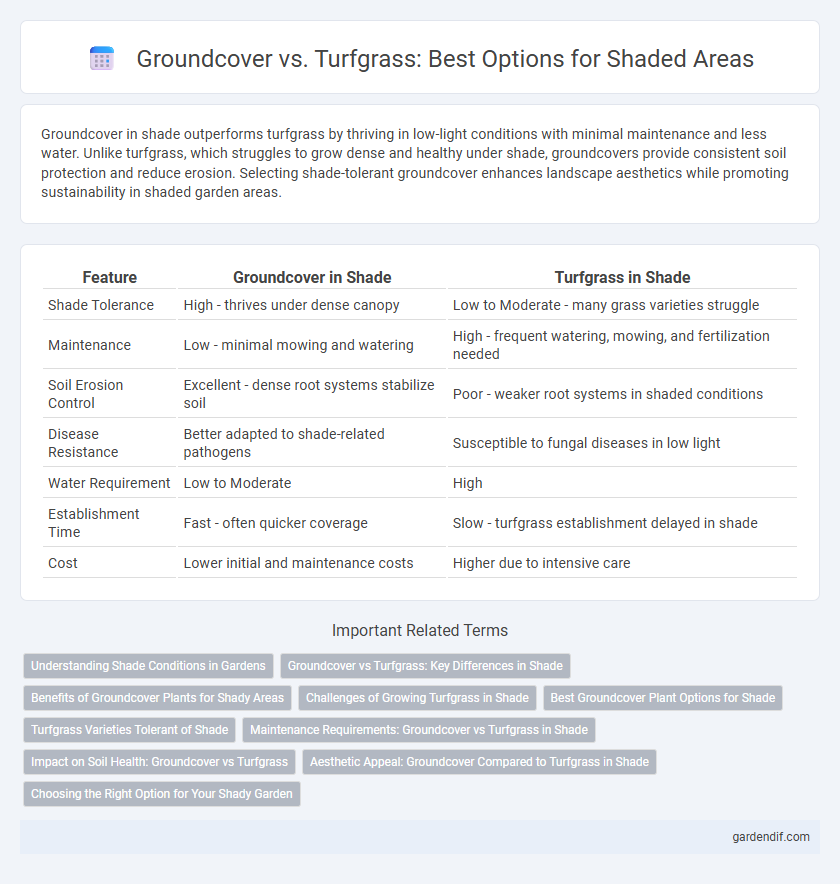
Groundcover in Shade vs Turfgrass in Shade Illustration
Groundcover in shade outperforms turfgrass by thriving in low-light conditions with minimal maintenance and less water. Unlike turfgrass, which struggles to grow dense and healthy under shade, groundcovers provide consistent soil protection and reduce erosion. Selecting shade-tolerant groundcover enhances landscape aesthetics while promoting sustainability in shaded garden areas.
Table of Comparison
| Feature | Groundcover in Shade | Turfgrass in Shade |
|---|---|---|
| Shade Tolerance | High - thrives under dense canopy | Low to Moderate - many grass varieties struggle |
| Maintenance | Low - minimal mowing and watering | High - frequent watering, mowing, and fertilization needed |
| Soil Erosion Control | Excellent - dense root systems stabilize soil | Poor - weaker root systems in shaded conditions |
| Disease Resistance | Better adapted to shade-related pathogens | Susceptible to fungal diseases in low light |
| Water Requirement | Low to Moderate | High |
| Establishment Time | Fast - often quicker coverage | Slow - turfgrass establishment delayed in shade |
| Cost | Lower initial and maintenance costs | Higher due to intensive care |
Understanding Shade Conditions in Gardens
Groundcover plants thrive in shade by adapting to low-light conditions, offering superior soil erosion control and moisture retention compared to turfgrass, which struggles with reduced photosynthesis and patchy growth. Understanding shade intensity and duration in gardens helps select shade-tolerant groundcovers like pachysandra, ajuga, or ferns that maintain dense, healthy foliage under tree canopies. Properly assessing shade conditions enables optimized groundcover establishment, ensuring robust plant health and minimizing maintenance challenges inherent in growing turfgrass in shaded environments.
Groundcover vs Turfgrass: Key Differences in Shade
Groundcover thrives in shade by forming dense, low-growing mats that suppress weeds and retain moisture, whereas turfgrass often struggles with thin, patchy growth due to limited sunlight. Groundcover species such as pachysandra, ajuga, and vinca minor tolerate low light and require less maintenance than turfgrass varieties like shade-tolerant fescues or ryegrass. Choosing groundcover over turfgrass in shaded areas enhances soil stability, reduces erosion, and offers year-round greenery despite limited photosynthesis.
Benefits of Groundcover Plants for Shady Areas
Groundcover plants thrive in shady environments where turfgrass often struggles due to limited sunlight, providing superior soil erosion control and moisture retention. These plants enhance biodiversity by creating habitats for beneficial insects and reducing weed growth, which decreases the need for chemical herbicides. Their low maintenance requirements and aesthetic variety make groundcovers a sustainable and visually appealing alternative to turfgrass in shaded garden areas.
Challenges of Growing Turfgrass in Shade
Turfgrass struggles in shade due to limited sunlight, which hinders photosynthesis, leading to weak growth and increased susceptibility to diseases. Poor air circulation and moisture retention under shaded canopies create ideal conditions for fungal infections and pest infestations. Groundcover plants, such as pachysandra or ivy, offer a resilient alternative by thriving in low-light environments and requiring less maintenance than turfgrass.
Best Groundcover Plant Options for Shade
Groundcover plants like Pachysandra, Ajuga, and Vinca Minor outperform turfgrass in shade by providing dense coverage and reducing soil erosion. Shade-tolerant groundcovers thrive under low light conditions where turfgrass struggles, maintaining vibrant greenery without excessive watering or mowing. Selecting species such as Lamium or Sweet Woodruff ensures durable, low-maintenance landscapes ideal for shaded environments.
Turfgrass Varieties Tolerant of Shade
Turfgrass varieties tolerant of shade, such as Fine Fescues, St. Augustinegrass, and Zoysia, thrive in low-light conditions where traditional turfgrasses struggle. These species exhibit deep shade tolerance by maintaining density and green color under tree canopies and shaded landscapes. Compared to groundcovers, shade-tolerant turfgrass offers a uniform, resilient lawn with better foot traffic resistance and aesthetic appeal in shaded environments.
Maintenance Requirements: Groundcover vs Turfgrass in Shade
Groundcover in shade requires significantly less maintenance than turfgrass, as it typically needs less frequent mowing, watering, and fertilizing due to its slower growth rate and adaptability to low light conditions. Turfgrass in shade often suffers from thinning and disease, necessitating regular overseeding, aeration, and higher inputs of water and nutrients to maintain a healthy lawn. Choosing shade-tolerant groundcovers like pachysandra, ajuga, or ivy reduces labor and resource use while providing dense, durable coverage under shaded canopies.
Impact on Soil Health: Groundcover vs Turfgrass
Groundcover plants in shaded areas enhance soil health by improving organic matter content and promoting microbial diversity, which leads to better nutrient cycling and soil structure. Turfgrass in shade often struggles with thin growth and compaction, reducing soil aeration and increasing susceptibility to erosion. Selecting groundcover over turfgrass under shade conditions supports long-term soil vitality and resilience.
Aesthetic Appeal: Groundcover Compared to Turfgrass in Shade
Groundcover in shade offers dense, lush foliage that thrives under low light, creating a rich, textured green carpet that enhances aesthetic appeal more effectively than turfgrass, which often appears thin and patchy in shaded areas. The diverse species of shade-tolerant groundcovers provide varied leaf shapes, colors, and seasonal interest, contributing to a visually dynamic landscape. Unlike turfgrass, which can suffer from uneven growth and discoloration in shade, groundcover maintains consistent coverage and vibrant greenery, ensuring a more attractive and resilient shaded garden.
Choosing the Right Option for Your Shady Garden
Groundcover plants thrive in shade by requiring less sunlight and offering improved soil erosion control compared to turfgrass. Turfgrass often struggles in shaded areas due to limited photosynthesis, resulting in thin, patchy growth that demands higher maintenance. Selecting shade-tolerant groundcovers like pachysandra or ivy promotes healthier, sustainable coverage for shady garden spaces.
Groundcover in Shade vs Turfgrass in Shade Infographic

 gardendif.com
gardendif.com